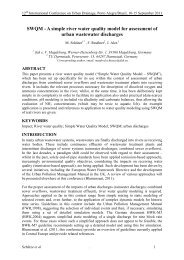Flexibility - a planning criterion for stormwater management
Flexibility - a planning criterion for stormwater management
Flexibility - a planning criterion for stormwater management
You also want an ePaper? Increase the reach of your titles
YUMPU automatically turns print PDFs into web optimized ePapers that Google loves.
11 th International Conference on Urban Drainage, Edinburgh, Scotland, UK, 2008<br />
An ideal UDMP would have tried to base future scenarios <strong>for</strong> the socio-economic<br />
development on expert knowledge. If a prediction of the socio-economic development is<br />
unclear or if skepticism is politically not opportune (which was the case in East Germany in<br />
the early nineties) than take flexibility and adaptiveness as decision criteria into account.<br />
FLEXIBILITY IN SYSTEM THEORY<br />
Form a system perspective each system is part of a hierarchy where systems of higher levels<br />
are made up of subsystems from lower levels, but not in the sense of a top-down sequence of<br />
authoritative control. Rather semi-autonomous levels are shaped from the interactions among<br />
a set of variables that share similar speeds. Each level communicates a small set of<br />
in<strong>for</strong>mation or quantity of material to the next level. In this sight the flexibility of a system<br />
depends on its capacity of adaptation and its resilience in recovering from perturbations.<br />
There<strong>for</strong>e resilience of a system refers to the ability to maintain structure and sel<strong>for</strong>ganization<br />
of the subsystems of each level, if the whole system is confronted with external<br />
stress [Holling 2001].<br />
Renewal and readjustment are essential elements of this process. Renewal in components<br />
helps a system to persist. There<strong>for</strong>e, <strong>for</strong> a system to be sustainable, its subsystems must have<br />
the possibility to go through renewal cycles. As long as the system can adapt in this way, it is<br />
sustainable. Since every process of adaptation is only a temporary solution to changing<br />
conditions, it is of high importance to maintain diversity within the system. Diversity<br />
represents a repertoire of alternative options and increases the possibility that altered<br />
conditions can be successfully met. The consequence of implementing big infrastructure is<br />
that high sunk costs make systems extremely inflexible [Tillman et al. 2005], one way to<br />
avoid this scenario and implement diversity, is through small scale modular design. In this<br />
way diversity:<br />
• Avoids dissipation that comes along with the link-up of processes<br />
• Enables adaptation to regional conditions (special environmental requirements, different<br />
social acceptance of technologies, etc.)<br />
Small scale modular diversity exponentially increases the amount of possible configurations<br />
that can be achieved from a given set of inputs. This increases the flexibility of a system and<br />
provides <strong>for</strong> the characteristics of a complex adaptive system. The system is equipped with<br />
internal degrees of freedom and distributed control. As a result, it has a higher resilience in<br />
relation to both: socio-economic and natural environment. This allows diversity to contribute<br />
to long term stability through adaptive flexibility. Special regional conditions can more<br />
efficiently be met by choosing exactly that measure <strong>for</strong> each special issue that fulfils the<br />
spatial profile appropriately. This approach allows <strong>for</strong> using the best practices to fulfill<br />
different criteria. In reference to classical value analysis that adds achievement of criteria of a<br />
certain measure in total, the aggregated value of a system made of different small scale<br />
modular components replaces a value of greater homogeneity because low accomplishments<br />
in different criteria that might occur in a large scale system can be bypassed in a system<br />
consisting of small scale modular subsystems, in choosing a measure meeting the special<br />
requirement profile. In this way the homogeneity of value of a certain measure symbolizes the<br />
adaptive flexibility of a system.<br />
4 <strong>Flexibility</strong> - a <strong>planning</strong> <strong>criterion</strong> <strong>for</strong> <strong>stormwater</strong> <strong>management</strong>













